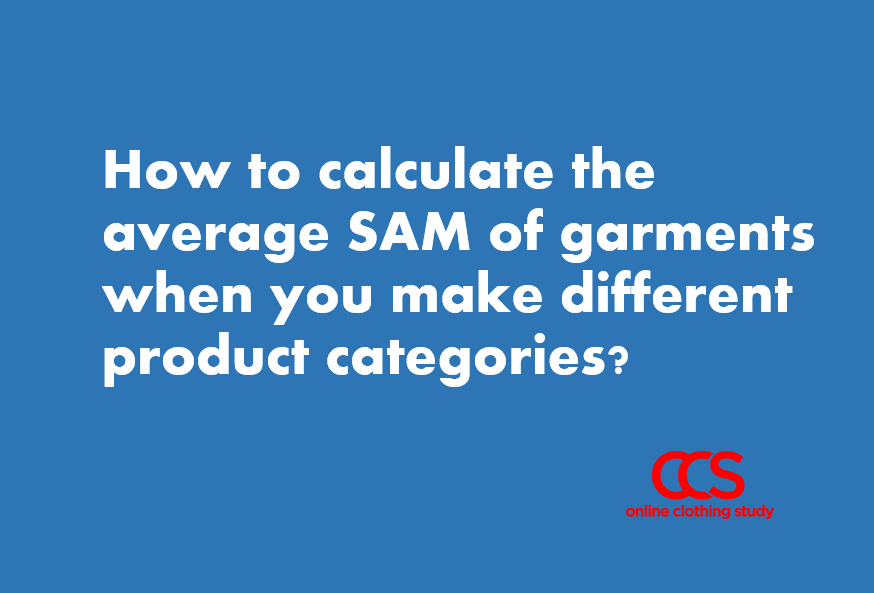
It is often required to calculate the average SAM of the garments of a factory. When you speak to a buyer or even to someone in a business meeting, you might be asked this question. What is the correct way to derive the average SAM? I will show you it in this post through a Q&A. This question is received from an industrial engineer working in a garment factory.
The question:
I have some doubts about the average SAM calculation. For example, in a month we produce 40% basic (SAM-20 Min), 20% semi fashion items (of SAM-28 Min), and 40% high fashion items (of SAM- 52 Min).
My factory is completely set for basic and average semi fashion jean's but when start production of high fashion jean's my efficiency goes down and productivity also goes down due to this month's results not up to the requirement.
When we make a KPI report average SAM seems 33.33 Min. (Average of 20 minutes, 28 minutes, and 52 minutes). As per this avg SAM my production quantity seems low.
Is this the correct way to calculate average SAM or any other method for calculation?
Waiting for your advice.
My factory is completely set for basic and average semi fashion jean's but when start production of high fashion jean's my efficiency goes down and productivity also goes down due to this month's results not up to the requirement.
When we make a KPI report average SAM seems 33.33 Min. (Average of 20 minutes, 28 minutes, and 52 minutes). As per this avg SAM my production quantity seems low.
Is this the correct way to calculate average SAM or any other method for calculation?
Waiting for your advice.
Answer:
The current method that you are using for calculating the average SAM of different products is incorrect. By using this average of 33.33 minutes (from your example), you will get an incorrect result for calculating other KPIs.
So, what is the correct method for calculating the average SAM of garments?
In this situation, the right way to calculate the average product SAM of your factory for apparel items is to calculate the weighted average SAM of the products.
Weighted average SAM should be calculated based on the monthly production volume of each item. Or based on the ratio of production volume and individual product SAM.
You have data of production volume ratio of 3 product categories (40%, 20%, and 40%) that you make in your plant. You have the product-wise SAM. Use one of the following methods to calculate the average SAM.

Weighted average SAM= (Product-1 SAM x Ratio) + (Product-2 SAM x Ratio) + (Product-3 SAM x Ratio)/ (Sum of Ratios)
= ((20 x 2) + (28 x 1) + (52 x 2))/ (2+1+2)
= (40 + 28 + 104)/5 Minute
= 172/5 Minute
=34.4 Minute
Weighted average SAM= (Product-1 SAM x production%) + (Product-2 SAM x production%) + (Product-3 SAM x production%)
= (20 x 0.4) + (28 x 0.2) + (52 x 0.4)
= (8.0 + 5.6 + 20.8) Minute
=34.4 Minute
In both ways, we get the same result. The weighted average SAM is 34.4 Minute
Weighted average SAM should be calculated based on the monthly production volume of each item. Or based on the ratio of production volume and individual product SAM.
You have data of production volume ratio of 3 product categories (40%, 20%, and 40%) that you make in your plant. You have the product-wise SAM. Use one of the following methods to calculate the average SAM.

Method-1:
Weighted average SAM calculation formulaWeighted average SAM= (Product-1 SAM x Ratio) + (Product-2 SAM x Ratio) + (Product-3 SAM x Ratio)/ (Sum of Ratios)
= ((20 x 2) + (28 x 1) + (52 x 2))/ (2+1+2)
= (40 + 28 + 104)/5 Minute
= 172/5 Minute
=34.4 Minute
Method-2:
Another way of calculating the weighted average SAM is from the percentage of total production volume. The formula isWeighted average SAM= (Product-1 SAM x production%) + (Product-2 SAM x production%) + (Product-3 SAM x production%)
= (20 x 0.4) + (28 x 0.2) + (52 x 0.4)
= (8.0 + 5.6 + 20.8) Minute
=34.4 Minute
In both ways, we get the same result. The weighted average SAM is 34.4 Minute
Method-3:
You can even calculate the weighted average SAM of garments that you make from the actual production volume by style.In your example, you have not given any production data, so I am taking one example by keeping the product-wise volume ratio the same. We will use the same SAM for each type of product. See the below table for monthly production volume.

Weighted average SAM= ((Basic garment SAM x product-1 Qty) + (Semi fashion garment SAM x product-2 Qty) + (High fashion garment SAM x product-3 Qty))/Sum of total production in a month

Weighted average SAM= ((Basic garment SAM x product-1 Qty) + (Semi fashion garment SAM x product-2 Qty) + (High fashion garment SAM x product-3 Qty))/Sum of total production in a month
= ((20x4000)+(28x2000)+(52x4000))/(4000+2000+4000)
=(80000+56000+208000)/10000
=34.4
By calculating the weighted average product SAM, you will better idea of the SAM and you can estimate your production capacity. This will also help you calculate the real performance of your plant.
I hope this guide will help you understand how one should correctly calculate the average garment SAM (standard minute) when multiple products are made in the factory and each garment has different SAM and a different production volume.
I hope this guide will help you understand how one should correctly calculate the average garment SAM (standard minute) when multiple products are made in the factory and each garment has different SAM and a different production volume.
